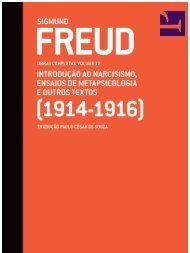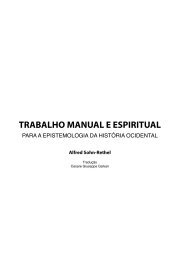Perversion the Social Relation
Perversion the Social Relation
Perversion the Social Relation
- No tags were found...
You also want an ePaper? Increase the reach of your titles
YUMPU automatically turns print PDFs into web optimized ePapers that Google loves.
Contamination's Germinations 191earlier definition. Brooks makes it clear that <strong>the</strong> issue of repetition isvery much bound up in <strong>the</strong> symbolic register: "Repetition is a symbolicenactment referring back to unconscious determinants, progressive inthat it belongs to <strong>the</strong> forward thrust of desire, and is known by way ofdesire's workings in <strong>the</strong> signifying chain, but regressive in its points ofreference." 7 Brooks plays a bit fast and loose with "desire" and "drive,"but his focus on <strong>the</strong> role of "textual energetics" throughout Reading for<strong>the</strong> Plot is instructive, and <strong>the</strong> point here is that Freud's account of repetitionleads him to <strong>the</strong> proposition of <strong>the</strong> death instinct as an urge torestore a prior state of existence.Taking things to <strong>the</strong> symbolic level, and given Freud's insistence on<strong>the</strong> stasis of <strong>the</strong> death drive, it might seem odd to link thanatos to narrative,which is fundamentally about transformation, succession, progressra<strong>the</strong>r than stasis or equilibrium. Indeed, Brooks himself has to balance<strong>the</strong> role of <strong>the</strong> death drive in narrative—working toward <strong>the</strong> end, binding<strong>the</strong> text's freely mobile energy to <strong>the</strong> conclusion and its quiescence—with <strong>the</strong> plot's necessary deferral of <strong>the</strong> end. The story goes somethinglike this: "Narratable existence is stimulated into a condition of narratabifety,to enter a state of deviance and detour . .. before returning to<strong>the</strong> quiescence of nonnarratable existence." 8 But this account rendersnarrative as <strong>the</strong> drive to <strong>the</strong> nonnarratable, without accounting for howtransformation might occur, or differences in <strong>the</strong> nonnarratable itself.Poetic forms like <strong>the</strong> villanelle or <strong>the</strong> pantoum that hinge on repetitionare, in fact, construed to be anti-narrative, and would thus seem morelikely sites of expression of <strong>the</strong> death drive in discourse. Part of <strong>the</strong> issue,however, is <strong>the</strong> very division of <strong>the</strong> drive into two forms; Lacan willlater posit in his reading of Freud that <strong>the</strong>re is only one drive, but <strong>the</strong>limits of Brooks's reading suggest that <strong>the</strong>re might be something moreat stake in drive <strong>the</strong>ory than <strong>the</strong> life drive's combinatory powers and<strong>the</strong> death drive's quiescence. Like <strong>the</strong> contradictions of <strong>the</strong> drive, narrativeinvolves <strong>the</strong> tension between telos and deferral, between closureand divagation.Although I am not <strong>the</strong> first to link <strong>the</strong> drives to narrative, I want toconsider how <strong>the</strong>se narratives render contamination as itself a symptomof a different, possibly even perverse, drive, veering off course fromei<strong>the</strong>r coalescence or stasis. To do so requires that we parcel out <strong>the</strong> driveeven fur<strong>the</strong>r, provisionally positing yet ano<strong>the</strong>r form of instinct. This








